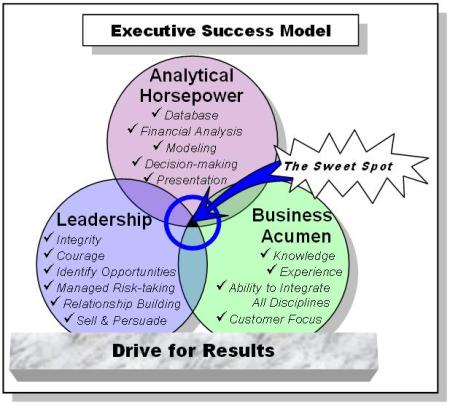Intro
America’s economy continues to grow in complexity… while we face greater competition from overseas. We cannot afford to conduct business as usual.
In order to maintain success as executives, we must not only respond to change… we have to drive that change. We must lead and adapt our organizations so we can respond to customer needs faster and more effectively than our competitors.
The Model
In my experience and discussions with other leaders, I have discovered four attribute areas that are essential for success in our contemporary business landscape.  One, Drive for Results, forms the foundation for the other three: Leadership, Business Acumen, and Analytical Horsepower. Drive for Results, Leadership, and Business Acumen have been common to business leaders for generations. They are the tickets to entry and represent a substantial portion of what I call the Executive Success Model.
One, Drive for Results, forms the foundation for the other three: Leadership, Business Acumen, and Analytical Horsepower. Drive for Results, Leadership, and Business Acumen have been common to business leaders for generations. They are the tickets to entry and represent a substantial portion of what I call the Executive Success Model.
The last area, Analytical Horsepower, is often neglected by business leaders as they progress through their careers. Sure, some have the ability to make effective decisions. They can often do so rapidly after seeing data and analysis presented to them. But… their decision quality is limited to the accuracy and thoroughness of the analysis presented to them.
A recent Harvard Business School Working Knowledge article discusses the importance of “Executive Intelligence”. In that article, author Justin Menkes is quoted: “…too much emphasis has been given to personality and style and too little to types of intelligence that enhance leadership performance.” (1)
A results-driven leader who possesses business acumen and has the following abilities will trounce the competition:
- Extract and analyze data
- Model alternatives
- Make timely and accurate decisions
- Persuasively present decisions to senior execs
Conclusion
In order to succeed as the type of leader today’s businesses need, executives must possess: Drive for Results, Leadership, Business Acumen, and Analytical Horsepower. These represent the sweet spot of the Executive Success Model.
—————————-
(1) HBS Working Knowledge. How Important Is “Executive Intelligence” for Leaders?
James Heskett. July 5, 2006
http://hbswk.hbs.edu/item/5449.html#comments
——————————————————–
About the author:
Dirk Armbrust is an executive with broad, results-oriented experience ideal for a company seeking to grow. This experience is built on a foundation of Leadership, Strategy, Business Development, Sales, Customer Focus, Financial Analysis, Technology Integration, Supply Chain, and Operations Excellence. Dirk developed these skills while leading teams in industrial and consumer packaging, distribution, and high-tech and contract manufacturing. He has a demonstrated history of bringing out the best in people to drive sales, cut costs, and grow the bottom line.
View Dirk’s professional profile at: http://bit.ly/44Vih3